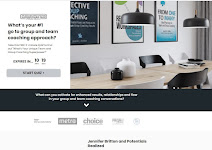This week in the Building Your Team and Group Coaching
Toolkit I want you to think about how you
are incorporating somatic and
kinesthetic approaches for working with groups and teams. While coaching is a
verbal modality, incorporating somatic and kinesthetic approaches provide an
opportunity to gain new insight from a different perspective.
What do I mean with somatic and kinesthetic approaches?
These approaches incorporate movement, doing and physical action. It may also
reconnect people with their body. With this in mind, there is a wide variety of
different approaches we might incorporate into our work as group and team
coaching including (and not limited to):
- Making things more tactile and physical. Instead of doing a Wheel of Life on paper, what about doing it on the floor? Instead of just talking about strengths, is there a way you can make them more visual? Instead of talking about values, is there a way people can body them.
- Using annotation: In the virtual space we often are focused on dialogue. It is possible to get people more active during the call using annotation. Annotation in most virtual platforms allows us to draw, write and even map things out visually.
- With teams, consider getting them to undertake something hands on. With my own roots originally in the experiential education sector, I find I still incorporate several hands-on activities including building things, or solving problems together with materials. Essential to this approach is giving hem time at the end to not only debrief what happened during the exercise, but to consider how these behaviors, values, beliefs are showing up in their own work.
- Building in reflective walks – For many years I ran multiple summer programs in rustic settings up north. Providing space for reflective walks always created multiple layers of learning.
- Creating models- Getting clients active with creation is another opportunity to create expanded awareness and insight. Consider giving the space for people to create a model – whether it’s out of aluminum foil, clay or other materials. IT’s not only the process of creation but the value a structure provides in the coaching process.
For resources around more experiential and kinesthetic
approaches you may want to consider exploring:
·
Marlena Field’s work around Body-Centered
Coaching
·
Project Adventure’s experiential resources from
the 80s onwards
·
What your virtual platform allows you to do. Can
you use annotation? Breakouts?
·
Is there something you can send in advance of
your next virtual call to make it more kinesthetic?
Note: always ensure people
have identified hazards in their own areas before moving around. This holds
true for streaming and movement.
Six Questions around kinesthetic approaches: As you consider
incorporating more kinesthetic approaches consider these questions
1.
From this exercise, what do you notice?
2.
Accessing your head, heart and guts – what does
each one of them say?
3.
What is transferable from this exercise to our
everyday experience?
4.
What helped? What got in the way?
5.
Where do you sense this?
6.
What’s going to keep this visible?
Enjoy the conversation,
Jennifer
Jennifer Britton, CPCC, PCC – Potentials Realized
Leadership | Teamwork | Business Success
Author of Effective Virtual Conversations (2017), Coaching Business Builder Workbook and Planner (2018) and From One to Many: Best Practices for Team and Group Coaching (2013)
Follow along with the #90DaysPlanDoTrack series over at Instagram @CoachingBizBuilder
Join the conversation at the Conversation Sparker Zone - our online community where you can explore virtual and team issues, coaching, productivity and business development)
Leadership | Teamwork | Business Success
Author of Effective Virtual Conversations (2017), Coaching Business Builder Workbook and Planner (2018) and From One to Many: Best Practices for Team and Group Coaching (2013)
Follow along with the #90DaysPlanDoTrack series over at Instagram @CoachingBizBuilder
Join the conversation at the Conversation Sparker Zone - our online community where you can explore virtual and team issues, coaching, productivity and business development)
Join us for an upcoming ICF CCE approved program - Group Coaching Essentials (starts Friday June 7 - 8.75 CCEs), Advanced Group and Team Coaching Practicum (starts Monday July 8: 10 CCEs) or the Virtual Facilitation Essentials(starts Monday June 3rd - 4 spots open - 8.5 CCEs)











No comments:
Post a Comment